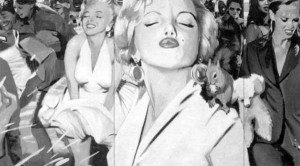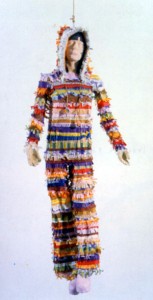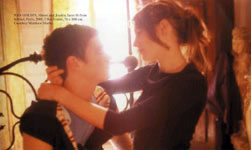For Flash Art

As the backdrop for countless cold-war spy dramas, Moscow’s Red Square is usually depicted as cold and menacing, perhaps with a dusting of snow and certainly with a few suspicious looking men lingering in trench coats. But theses stereotypes were nowhere to be seen in Russian artists Alexander Vinogradov and Vladimir Dubossarsky’s painting installation at Deitch Projects. The onion-domed cathedral and the Kremlin are visible in the distance but the foreground is dominated by beautiful young things who flirt, play and apply makeup with the best of the international jet set. Presented as one continuous painting, the scene in Red Square changes into different locations, all a backdrop for the artists’ engagement with the post-Glasnost world of privilege enjoyed by the wealthy in Moscow and abroad.
Vinogradov and Dubossarsky, known for their fantastical paintings of utopian scenes, composed a surreal celebration of ‘fun’ for their first U.S. solo show. ‘Our Best World’ started out in Moscow but quickly jumped to a flowery meadow full of picnickers and ended up in a surreal anti-gravity world of floating toys and cartoon characters. Each scene was a composite of half-recognizable advertising images presented in an uncritical fashion. Amongst images of handsome young people enjoying themselves sat Madonna, flanked by cute animals and a cherub. The Material Girl played Madonna of the Commodity, benignly blessing the marriage of mass marketing and kitsch and granting the most superficial wishes of the consumer.
The characters in ‘Our Best World’ are the picture of health, happiness and economic prosperity. But their innocent delight in the good life is a mirage – a utopia created by marketers. Critics have questioned the apparent lack of irony in Vinogradov and Dubossarsky’s paintings, and there is little in this installation that directly critiques consumerism. However, the context of the installation completes the meaning of the artwork. Three years ago, before the economic slump, the terrorist attack on New York and, more recently, war in Iraq, ‘Our Best World’ might have been read as pure celebration and kitsch. But in light of current events, the painting simultaneously exposes viewers’ uncomfortable familiarity with the barrage of media images and forces the contrast between the happy world presented and the reality of daily life.



